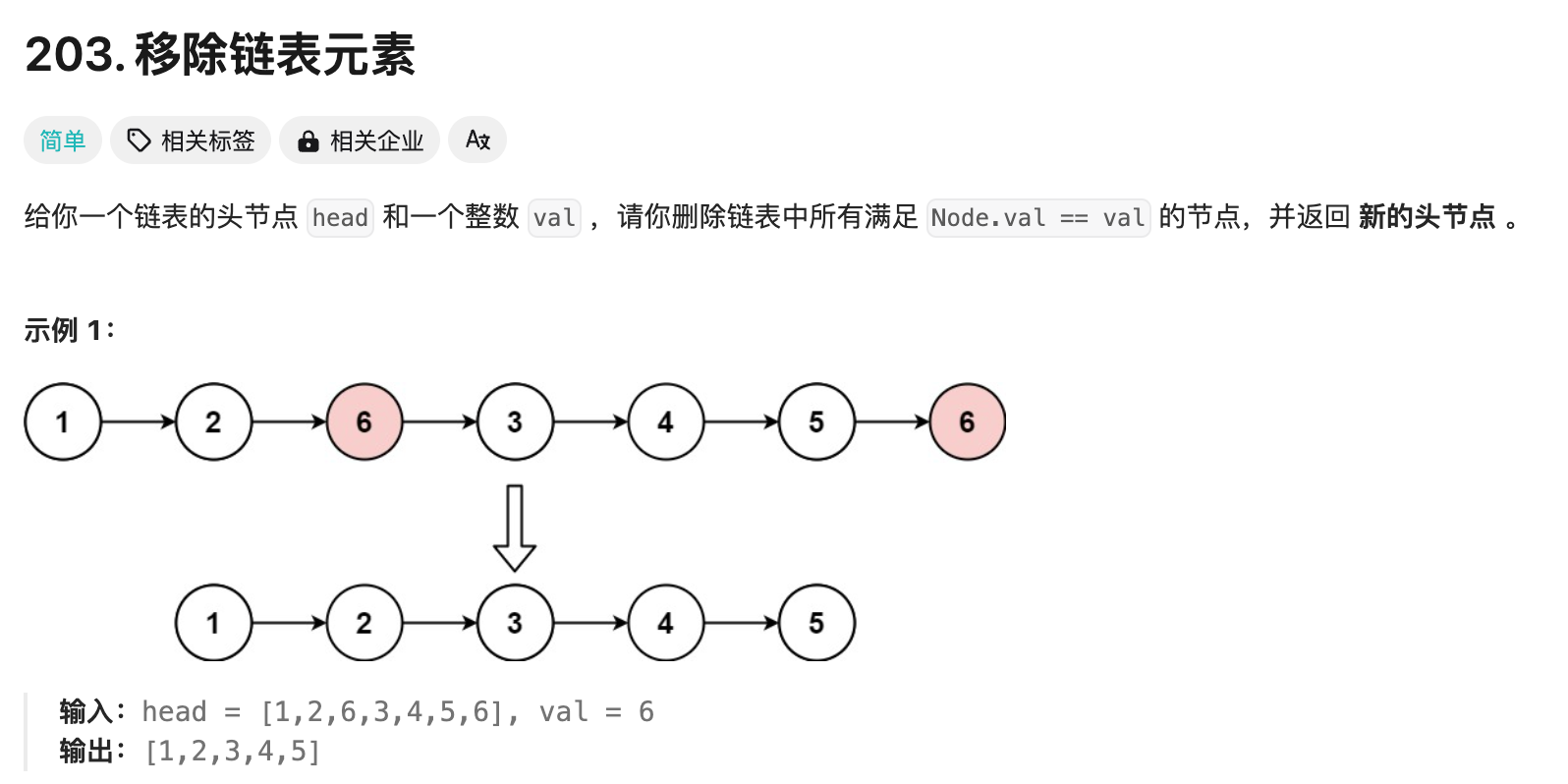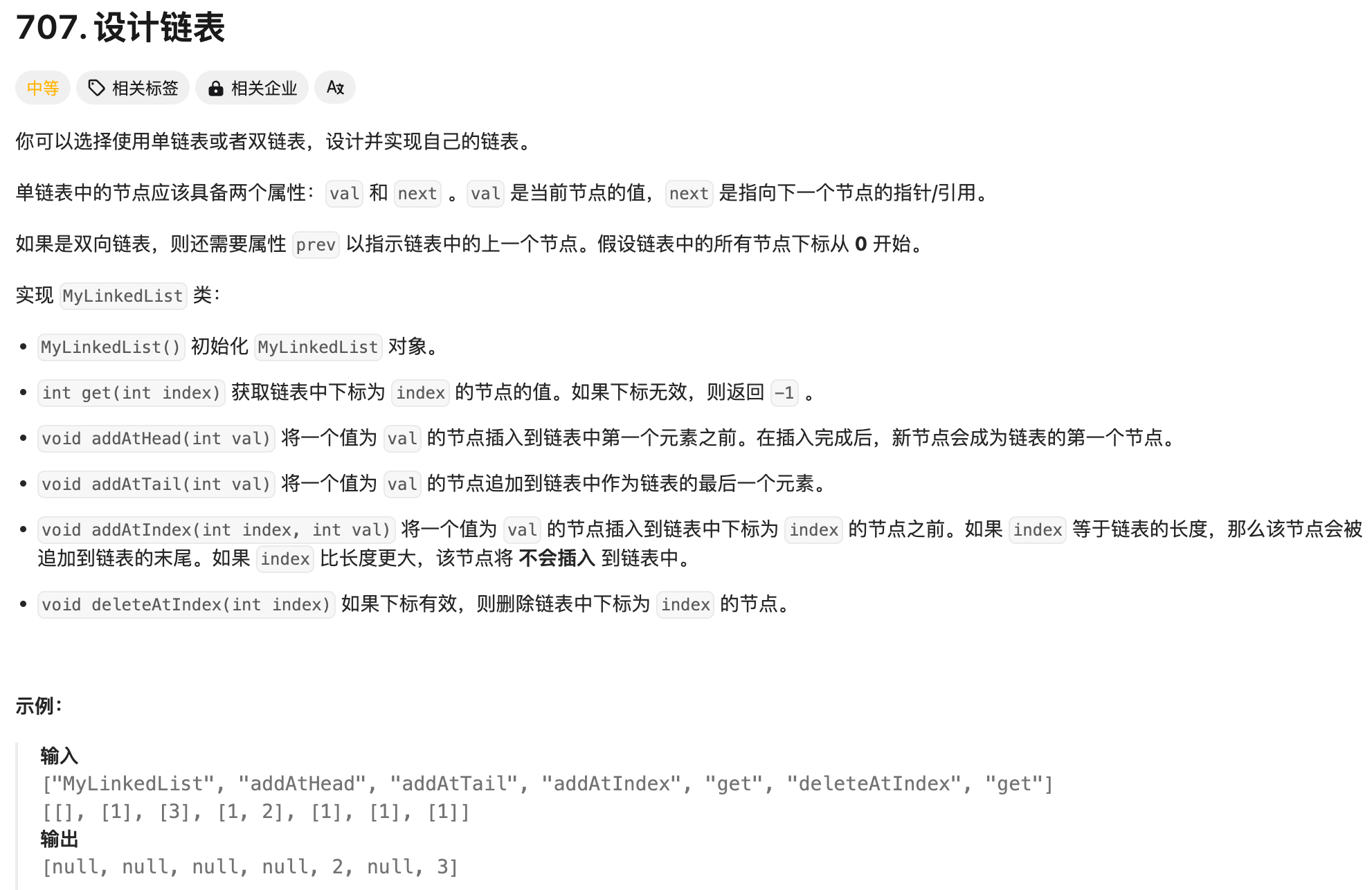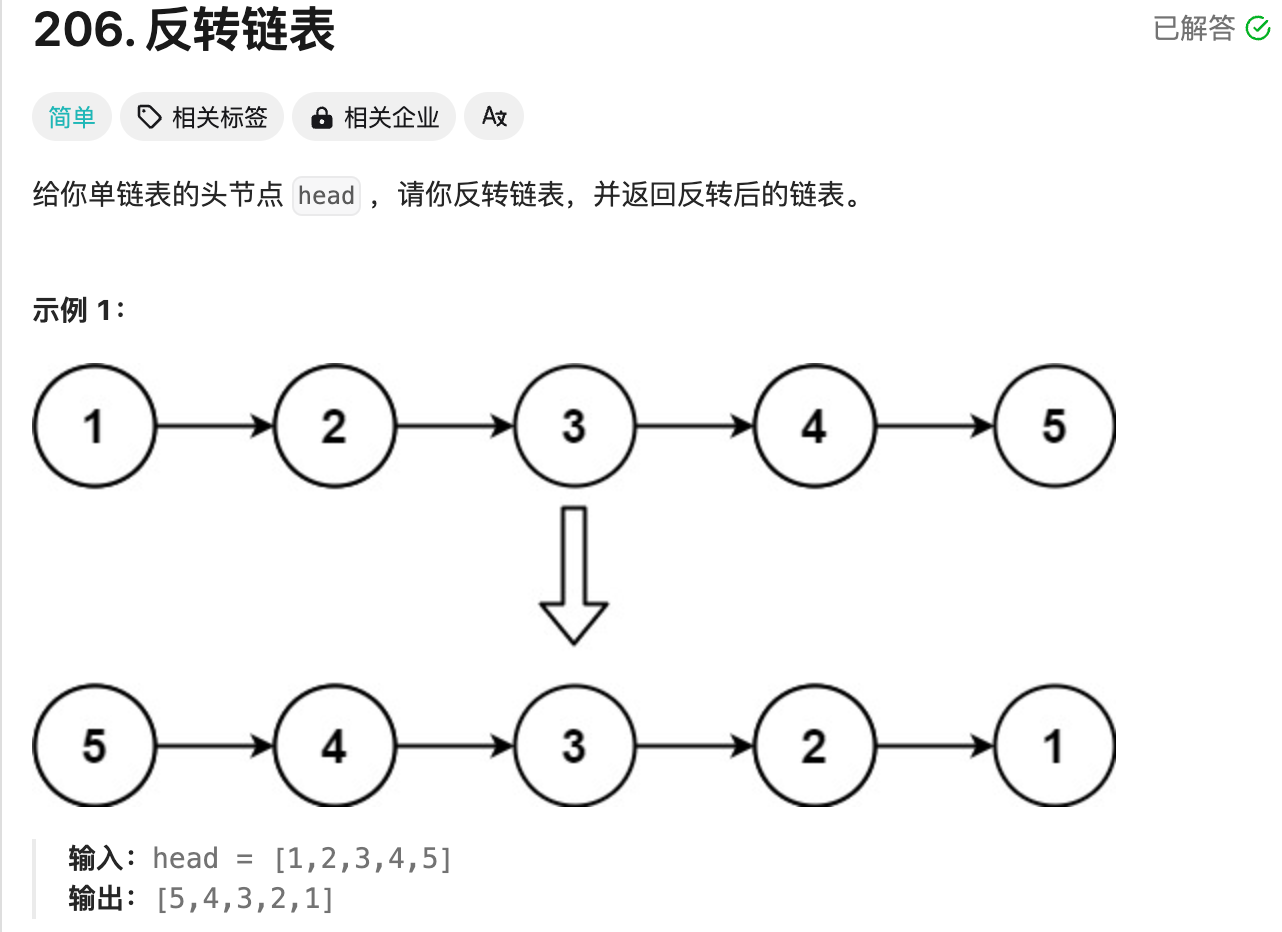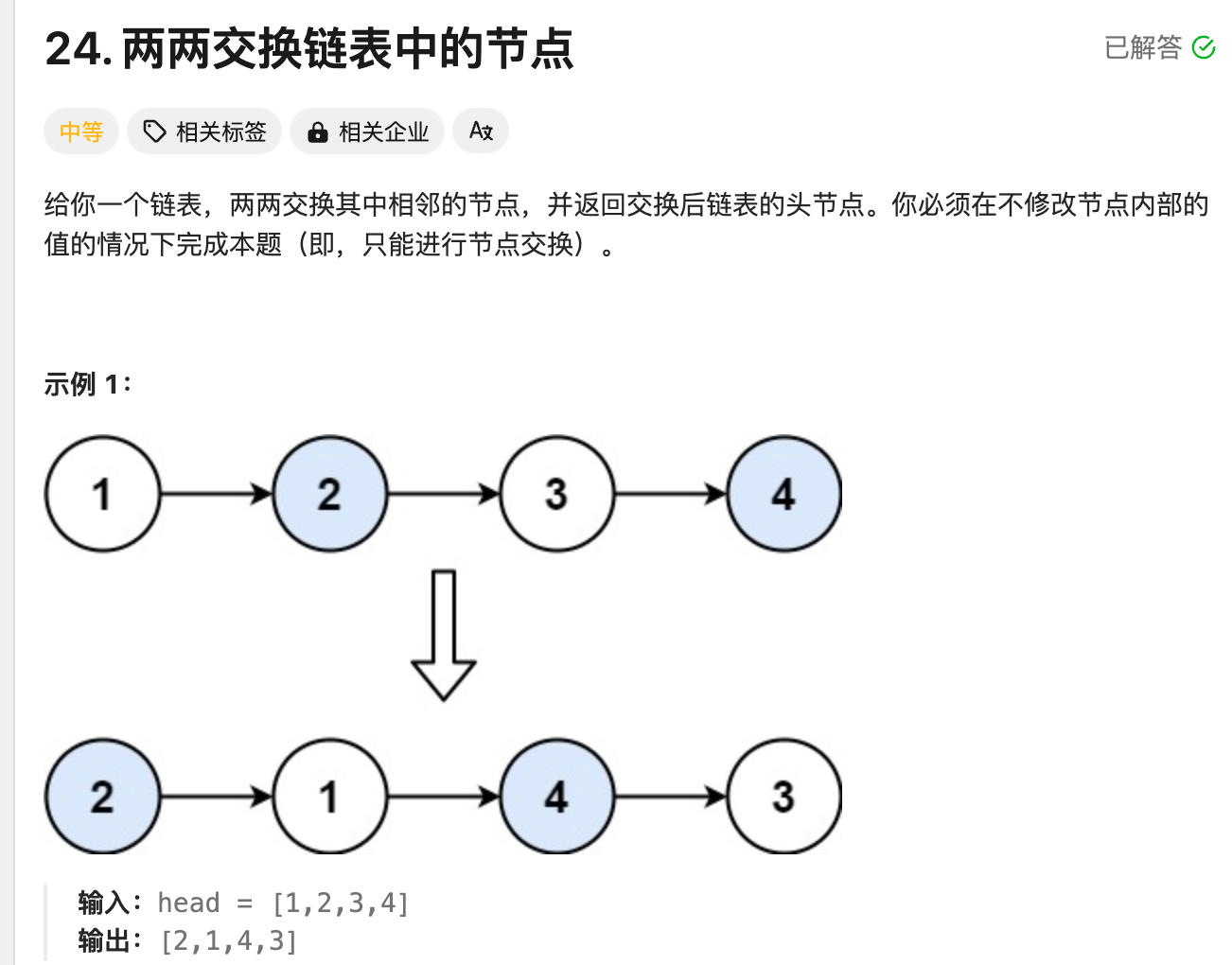链表算法题目¶
1. 移除链表元素¶
对应 LeetCode 题目:

这里就涉及到前面理论部分所讲的链表的删除操作。
但是在实际编写代码过程中可发现:
- 若直接采用节点 next 指针直接指向下一个节点的方式
- 则删除头部结点和其他结点的处理是不同的
所以下面我们期望通过一种方式来让两种方式的处理保持一致。
1.1 思路:借助虚拟头结点¶
通过设置一个虚拟头结点,这样原链表的所有节点就都可以按照统一的方式进行移除。

最后在返回头结点的时候,注意需要返回虚拟头结点的 next,具体代码如下:
- 时间复杂度:\(O(n)\),空间复杂度:\(O(1)\)
Go
/**
* Definition for singly-linked list.
* type ListNode struct {
* Val int
* Next *ListNode
* }
*/
func removeElements(head *ListNode, val int) *ListNode {
dummyHead := &ListNode{}
dummyHead.Next = head
cur := dummyHead
for cur != nil && cur.Next != nil {
if cur.Next.Val == val {
cur.Next = cur.Next.Next
} else {
cur = cur.Next
}
}
return dummyHead.Next
}
Rust
pub struct Solution;
// Definition for singly-linked list.
#[derive(PartialEq, Eq, Clone, Debug)]
pub struct ListNode {
pub val: i32,
pub next: Option<Box<ListNode>>,
}
impl ListNode {
#[inline]
fn new(val: i32) -> Self {
ListNode {
next: None,
val,
}
}
}
impl Solution {
pub fn remove_elements(head: Option<Box<ListNode>>, val: i32) -> Option<Box<ListNode>> {
let mut dummy_head = Box::new(ListNode::new(0));
dummy_head.next = head;
let mut cur = dummy_head.as_mut();
while let Some(nxt) = cur.next.take() {
if nxt.val == val {
cur.next = nxt.next;
} else {
cur.next = Some(nxt);
cur = cur.next.as_mut().unwrap();
}
}
dummy_head.next
}
}
2. 设计链表¶
对应 LeetCode 题目:

该题覆盖了链表所有的基础操作,需要前置掌握链表的理论部分。
2.1 思路:链表基础和哨兵节点¶
结合前面提到的虚拟头结点来完成该题目,具体代码如下:
- 时间复杂度:涉及 index 的相关操作为 \(O(index)\),其余为 \(O(1)\)
- 空间复杂度:\(O(n)\)
Go
type MyLinkedList struct {
dummyHead *SingleNode // 虚拟头节点
Size int // 链表大小
}
type SingleNode struct {
Val int // 节点的值
Next *SingleNode // 下一个节点的指针
}
func NewMyLinkedList() MyLinkedList {
newNode := &SingleNode{ // 创建新节点
0,
nil,
}
return MyLinkedList{ // 返回链表
dummyHead: newNode,
Size: 0,
}
}
func (this *MyLinkedList) Get(index int) int {
if this == nil || index < 0 || index >= this.Size {
return -1
}
cur := this.dummyHead.Next
for i := 0; i < index; i++ {
cur = cur.Next
}
return cur.Val
}
func (this *MyLinkedList) AddAtHead(val int) {
newNode := &SingleNode{
Val: val,
Next: this.dummyHead.Next,
}
this.dummyHead.Next = newNode
this.Size++
}
func (this *MyLinkedList) AddAtTail(val int) {
newNode := &SingleNode{Val: val}
cur := this.dummyHead
for cur.Next != nil {
cur = cur.Next
}
cur.Next = newNode
this.Size++
}
func (this *MyLinkedList) AddAtIndex(index int, val int) {
if index < 0 {
index = 0
} else if index > this.Size {
return
}
newNode := &SingleNode{Val: val}
cur := this.dummyHead
for i := 0; i < index; i++ {
cur = cur.Next
}
newNode.Next = cur.Next
cur.Next = newNode
this.Size++
}
func (this *MyLinkedList) DeleteAtIndex(index int) {
if index < 0 || index >= this.Size {
return
}
cur := this.dummyHead
for i := 0; i < index; i++ {
cur = cur.Next
}
if cur.Next != nil {
cur.Next = cur.Next.Next
this.Size--
}
}
/**
* Your MyLinkedList object will be instantiated and called as such:
* obj := Constructor();
* param_1 := obj.Get(index);
* obj.AddAtHead(val);
* obj.AddAtTail(val);
* obj.AddAtIndex(index,val);
* obj.DeleteAtIndex(index);
*/
Rust
pub struct Solution;
#[derive(Debug)]
pub struct MyLinkedList {
pub val: i32,
pub next: Option<Box<MyLinkedList>>,
}
/**
* `&self` means the method takes an immutable reference.
* If you need a mutable reference, change it to `&mut self` instead.
*/
impl MyLinkedList {
fn new() -> Self {
MyLinkedList { val: 0, next: None }
}
fn get(&self, index: i32) -> i32 {
if index < 0 {
return -1;
}
let mut i = 0;
let mut cur = &self.next;
while let Some(node) = cur {
if i == index {
return node.val;
}
i += 1;
cur = &node.next;
}
-1
}
fn add_at_head(&mut self, val: i32) {
let new_node = Box::new(MyLinkedList {
val,
next: self.next.take(),
});
self.next = Some(new_node);
}
fn add_at_tail(&mut self, val: i32) {
let new_node = Box::new(MyLinkedList { val, next: None });
let mut last_node = &mut self.next;
while let Some(node) = last_node {
last_node = &mut node.next;
}
*last_node = Some(new_node);
}
fn add_at_index(&mut self, index: i32, val: i32) {
if index <= 0 {
self.add_at_head(val);
} else {
let mut i = 0;
let mut cur = &mut self.next;
while let Some(node) = cur {
if i + 1 == index {
let new_node = Box::new(MyLinkedList {
val,
next: node.next.take(),
});
node.next = Some(new_node);
break;
}
i += 1;
cur = &mut node.next;
}
}
}
fn delete_at_index(&mut self, index: i32) {
if index < 0 {
return;
}
let mut i = 0;
let mut cur = self;
while let Some(node) = cur.next.take() {
if i == index {
cur.next = node.next;
break;
}
i += 1;
cur.next = Some(node);
cur = cur.next.as_mut().unwrap();
}
}
}
/**
* Your MyLinkedList object will be instantiated and called as such:
* let obj = MyLinkedList::new();
* let ret_1: i32 = obj.get(index);
* obj.add_at_head(val);
* obj.add_at_tail(val);
* obj.add_at_index(index, val);
* obj.delete_at_index(index);
*/
3. 翻转链表¶
对应 LeetCode 题目:

首先我们想到的最简单的解法就是,再定义一个新的链表来实现反转,此解法存在对内存空间浪费,最好可以原地。
3.1 思路:双指针或递归¶
- 双指针
分别定义 pre 和 cur 两个指针,每次移动 cur 时将 cur->next 指向 pre,最后返回 pre 指针即反转后的头节点。
注意在移动 cur 时,需要使用一个中间指针来暂存 cur 的当前位置,具体代码如下:
- 时间复杂度:\(O(n)\) ,空间复杂度:\(O(1)\)
Rust
// Definition for singly-linked list.
#[derive(PartialEq, Eq, Clone, Debug)]
pub struct ListNode {
pub val: i32,
pub next: Option<Box<ListNode>>,
}
impl ListNode {
#[inline]
fn new(val: i32) -> Self {
ListNode {
next: None,
val,
}
}
}
pub struct Solution;
impl Solution {
pub fn reverse_list(head: Option<Box<ListNode>>) -> Option<Box<ListNode>> {
let mut pre = None;
let mut cur = head;
while let Some(mut node) = cur.take() {
cur = node.next;
node.next = pre;
pre = Some(node);
}
pre
}
}
- 递归法
递归虽然会抽象一些,但实际上逻辑与双指针一致,核心都是不断移动 cur 后指向 pre,最后在 cur 为空的时候结束。
需要注意的是递归法所需要的空间为 n,具体代码如下:
- 时间复杂度:\(O(n)\) ,空间复杂度:\(O(n)\)
也存在相反的递归思路,即从后往前翻转指针指向。
Rust
impl Solution {
pub fn reverse_list_other(head: Option<Box<ListNode>>) -> Option<Box<ListNode>> {
fn reverse(mut cur: Option<Box<ListNode>>, mut pre: Option<Box<ListNode>>) -> Option<Box<ListNode>> {
if let Some(mut node) = cur.take() {
cur = node.next;
node.next = pre;
pre = Some(node);
return reverse(cur, pre);
}
pre
}
reverse(head, None)
}
}
4. 两两交换链表中的节点¶
对应 LeetCode 题目:

此题正常模拟,主要考查链表的操作,可使用画图来清晰表示。
4.1 思路:虚拟头节点或递归¶
交换的步骤如下图示:

虚拟头节点和递归的解法按照上面步骤,具体代码如下:
- 时间复杂度:\(O(n)\) ,空间复杂度:\(O(1)\)
Go
/**
* Definition for singly-linked list.
* type ListNode struct {
* Val int
* Next *ListNode
* }
*/
func swapPairs(head *ListNode) *ListNode {
if head == nil || head.Next == nil {
return head
}
dummyHead := &ListNode{0, nil}
dummyHead.Next = head
cur := dummyHead
for cur.Next != nil && cur.Next.Next != nil {
tmp := cur.Next
tmp1 := cur.Next.Next.Next
cur.Next = cur.Next.Next
cur.Next.Next = tmp
cur.Next.Next.Next = tmp1
cur = cur.Next.Next
}
return dummyHead.Next
}
func swapPairsOther(head *ListNode) *ListNode {
if head == nil || head.Next == nil {
return head
}
next := head.Next
head.Next = swapPairsOther(next.Next)
next.Next = head
return next
}
Rust
// Definition for singly-linked list.
#[derive(PartialEq, Eq, Clone, Debug)]
pub struct ListNode {
pub val: i32,
pub next: Option<Box<ListNode>>,
}
impl ListNode {
#[inline]
fn new(val: i32) -> Self {
ListNode {
next: None,
val,
}
}
}
pub struct Solution;
impl Solution {
pub fn swap_pairs(head: Option<Box<ListNode>>) -> Option<Box<ListNode>> {
let mut dummy_head = Box::new(ListNode::new(0));
dummy_head.next = head;
let mut cur = dummy_head.as_mut();
while let Some(mut node) = cur.next.take() {
if let Some(mut next) = node.next.take() {
node.next = next.next.take();
next.next = Some(node);
cur.next = Some(next);
cur = cur.next.as_mut().unwrap().next.as_mut().unwrap();
} else {
cur.next = Some(node);
cur = cur.next.as_mut().unwrap();
}
}
dummy_head.next
}
}